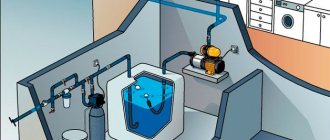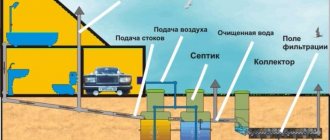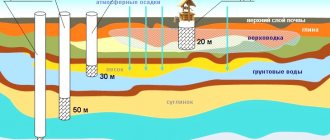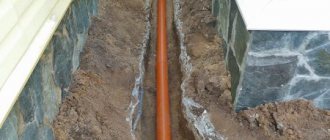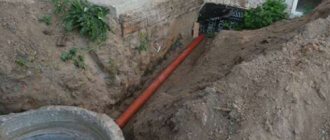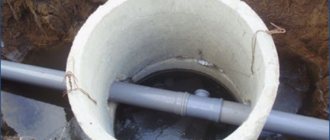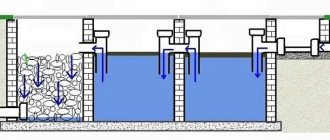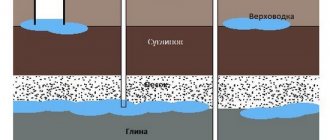Water supply to a private house from a well is a rather complex and time-consuming process. It is necessary to install various pressure boosting systems, as well as autonomous water supply. There are several main points:
- A dug well, at least 6–8 meters deep.
- Water supply main to the building.
- High power submersible pump, station.
- Pipeline layout.
- Installation of a tank (expansion), storage tank and other equipment.
Features of water supply from a well
A conventional well uses unconfined aquifers that “rest” on the first impermeable layer. It is believed that the optimal depth of a mine well lies within 6-10 m. Anything higher is rain or melt water that has not had time to undergo natural filtration, and the well itself is protected from its penetration. Therefore, to some extent, constructing a well is more complicated than a well, because the latter has a metal pipe that serves as a reliable barrier against “dirty” groundwater. If the well is deeper than 10 m, then it is more economically feasible to equip the well with “sand”.
Methods of water extraction depending on the occurrence of aquifers Source giropark.ru
Another feature that complicates the maintenance of a home’s water supply system from a well is the effect on the operation of the pump of solid particles present in suspension in the water.
If at a well the first stage of water purification begins at the level of the galloon mesh on the perforated part of the pipe, then the submersible pump for the well “works” with untreated water. The mechanical cleaning filter is part of its design and must be cleaned periodically.
And the main feature is the low flow rate (productivity) of most wells. It does not exceed 1 m3/hour, usually much less, and depends not only on the characteristics of the site, but also on weather factors in each year. That is, this value is not stable, as in a well “for lime”, and in dry years the water level may drop by one or two “rings”.
Installing filters
Finally, the final stage of building a water supply system in a dacha with your own hands from a well consists of installing a water filtration system. Purification of water for drinking and domestic purposes should always be multi-stage. In practice, this means installing several filters - mechanical and deep cleaning:
- A carbon filter is used at the first stage of cleaning. It filters out fine particles of sand, soil, silt, and vegetation well, which natural water certainly contains. Its principle of operation is simple - passing through it, water leaves impurities on the surface of the coal.
- Fine (deep cleaning) filters carry out multi-stage filtration using several cartridges made of special materials that perfectly separate harmful substances from water - oil residues, iron cations, heavy metals, fertilizer residues (nitrates), as well as pesticides, chlorides and other chemicals. The choice of one device or another depends on the chemical composition of the water specifically at your source.
IMPORTANT. Please note that any carbon filter is designed for a specific water pressure. Therefore, before purchasing it, if you doubt what the maximum pressure in your pipeline may be, it is better to measure it in test mode for several days, either increasing or decreasing the load. This will allow you to accurately learn about the operating characteristics of the system under high load conditions and choose the right carbon filter. And don’t forget one more important detail - the filter is used to purify only cold water.
Typically, these filters consist of several removable cartridges that need to be changed as they become clogged (the service life is always indicated in the instructions).
Video: installing filters during the construction of a country water supply system
Scheme of water supply to a house from a well
Fundamentally, the water supply to a private house from a well is no different from other types of autonomous systems and has the following form:
- source (well);
- pump (pumping station);
- storage capacity;
- external water supply;
- water treatment system;
- internal water supply;
- automation that controls the system.
The differences begin at the level of choosing the type of pump and when installing water supply from a well, which depends on the nature of living in the house.
Simplified scheme of autonomous water supply at home Source chrome-effect.ru
Types of well pumps
According to the installation method, there are two types of pumps for wells:
- superficial;
- submersible
There are also semi-submersible pumps that are installed in the form of a “float” on the water surface. But given the air type of cooling of the unit and the rather stringent requirements for operating temperatures, which cannot be ensured in the unventilated volume of a well shaft, they are not used for these purposes.
Surface (suction) pumps for water supply to a private house from a well are installed if the height of the water rise does not exceed 7-9 meters. You can increase this figure using an external ejector, but this will reduce the productivity of the equipment.
Self-priming pump with remote ejector Source bestprice.gr
See also: Catalog of companies that specialize in installation and design of sewerage and water supply
There are natural restrictions on operating temperatures - usually this indicator starts from +4°C. Therefore, a surface pump for a well for water supply to a house is used either as part of a summer water supply, or it is installed in a caisson or basement of a house (but no further than 10-12 m from the source). By the way, if the caisson is made correctly, and its “working” surface is below the freezing level, then this allows you to gain an additional 1.5-2 m of water rise height. But this advantage makes sense if your own pumping station is responsible for the further supply of water to the points of consumption.
Water supply diagram with a “boosting” pumping station after a storage tank Source mainavi.ru
Submersible well pumps are capable of raising water to a height of up to 100 m. This does not mean that there are wells of such depth, just a reserve is needed to raise water to a storage tank, which is located as high as possible, for example, in the insulated attic of a house. And the most powerful models can be used for the collective use of one source by several houses or cottages (if the well’s flow rate allows it).
Submersible pump for a well Source vse-o-kanalizacii.ru
When using such powerful equipment, there is no need to install another pump to supply water, since it flows from the hydraulic accumulator to the disassembly points due to the constant high pressure in the system.
The well differs from other sources in its versatility - borehole pumps can also be used to supply water. They differ from well ones in having a smaller diameter and longer length, with the same other characteristics. But the price for such equipment is higher.
Hydraulic accumulator
This is a mandatory element of the water supply system, regardless of the type of pump used. It is here that sensors and automation are installed that control turning the pump on and off and maintaining the required level of pressure in the system. If there is no storage tank (hydraulic accumulator), the pump will operate when any water consumer is turned on/off.
Surface pumps can be immediately equipped with their own capacity, and these models are called pumping stations.
But their hydraulic accumulator capacity is small (20-50 l), so they do not create any significant water reserve. The purpose of such a container is purely functional - the suction pump only works if there is water in the intake pipe and in it itself, and the water in the container simply “maintains” it in working condition. But even such a small reserve reduces the number of switches on/off of the station and eliminates the possibility of water hammer in the system.
Pumping station with automation and hydraulic accumulator Source home-help.com.ua
In the water supply scheme for a private house from a well with a submersible pump, high-capacity hydraulic accumulators are used. The larger the volume of the tank, the less often the automation operates when the pressure in the system decreases, and given that for any electric motor the “start” mode is the most difficult, this has a positive effect on the service life of the equipment.
When choosing a hydraulic accumulator model, take into account the volume of water consumption, which depends on the composition of the family. In addition, it is necessary to “link” its dimensions and type of installation (vertical or horizontal) to the characteristics of the room, internal pipe distribution, plus it is necessary to provide for the possibility of its maintenance.
There are also models of hydraulic accumulators that can ensure stable operation of the water supply system of a multi-family home Source remkasam.ru
Stage two. We prepare everything you need
Water supply from a wooden well
The procedure for constructing wells is not regulated by any government regulations or standards. The classical device was formed for more than one century until it acquired its modern form.
To make a well with your own hands, you need to prepare:
- a tripod made of metal corners or wooden poles;
- winch;
- rope ladder;
- shovel;
- scrap;
- material for strengthening the mine.
A well made of concrete rings
Regarding the last point, the most promising material is concrete rings. They are strong (reinforced with steel rods ø1 cm or more), durable (service life is 50 years), frost-resistant and waterproof.
| product name | Height x Wall thickness, cm | Internal diameter, cm | Weight, kg |
| KS-7−1 | 10x8 | 70 | 46 |
| KS-7−1.5 | 15x8 | 70 | 68 |
| KS-7−3 | 35x8 | 70 | 140 |
| KS-7−5 | 50x8 | 70 | 230 |
| KS-7−9 | 90x8 | 70 | 410 |
| KS-7−10 | 100x8 | 70 | 457 |
| KS-10-5 | 50x8 | 100 | 320 |
| KS-10-6 | 60x8 | 100 | 340 |
| KS-10-9 | 90x8 | 100 | 640 |
| KS-12-10 | 100x8 | 120 | 1050 |
| KS-15-6 | 60x9 | 150 | 900 |
| KS-15-9 | 90x9 | 150 | 1350 |
| KS-20-6 | 60x10 | 200 | 1550 |
| KS-20-9 | 90x10 | 200 | 2300 |
| KO-6 | 7x12 | 58 | 60 |
| KS-7-6 | 60x10 | 70 | 250 |
Concrete rings can be:
- wall (abbreviation - KS), which are used to arrange the neck and are suitable for all types of wells;
- additional - used in cases where standard options are not suitable, because these have non-standard sizes;
- Reinforced concrete rings - used for drainage and sewer wells, communication systems, gas and water supply.
Well ring
There are other types - with a covering slab, with a bottom, prefabricated, etc. To avoid displacement of the rings after installation, they are equipped with special grooves that prevent the moment of displacement.
Note! For a well in a suburban area, it is best to use wall products KS-10 or KS-15 (the numbers are the internal diameter in decimeters).
After choosing a location and preparing everything necessary, we can begin construction.
Features of summer external water supply
Depending on the seasonality of living in the house, methods of laying the external part of the water supply system are chosen.
If this is a house outside the city, and people live in it only during the warm season, then you can choose a “summer” water supply scheme.
In this case, if the depth of the well allows, a surface pump is used, which can be installed simply under a canopy that protects it from precipitation and the sun. And they save significant money on the arrangement of the caisson (pit, walls, insulation, stairs, roof, sealed hatch).
The water pipeline from the pump to the house can be laid according to a “budget” scheme, using shallow trenches, the depth of which is chosen so as not to damage the pipes when digging up the site.
This type of pipe laying is suitable for a dacha or a “summer” house in a village Source izhevsk.ru
You can generally lay pipes on the surface of the ground, but they obviously will not decorate the landscape, and at the end of the season they will have to be dismantled and hidden “under lock and key”.
Another savings item is the entry into the house. The pipe can be routed either through the base or through the wall altogether. And there is no need to drill a hole in a monolithic or prefabricated foundation if it was not provided for during construction.
The main disadvantage of the summer water distribution scheme is the need to drain water from the system at the end of the season. Therefore, when arranging the underground part, the pipes are laid with a slight slope towards the source and a branch with shut-off valves is specially installed so that the water can be drained by gravity after the pump is turned off.
How to hang and secure with your own hands
To prevent the device from ending up at the bottom during operation, it is necessary to securely fasten it with a hose to the wall of the shaft on a metal structure.
- A square-shaped frame with brackets at the corners for fixing to the wall is made from a steel corner using a welding unit.
- Two channels are welded along the diagonals of the square, and a hole is made at their intersection.
- The frame is rigidly fixed on top of the mine casing using brackets.
- A steel cable is passed through the hole in the channel, and a loop is crimped at its end to hold it on the structure.
- The pump is suspended from the safety rope and is used to remove it from the well.
Advantages of winter external water supply
When installing a surface-type pumping station in an insulated caisson (or basement of a house), it is more advisable to arrange an external water supply system according to the winter scheme. Even if the house is intended for seasonal living, and in winter it is visited “occasionally”, the water from the external part of the water supply system can not be drained, but only for the internal water supply. In this case, after the house is “heated”, it will be much easier to start the pump and water supply system.
A submersible well pump for water supply at home does not have the same starting difficulties as a suction pump. But the fact that the external part of the water distribution circuit in a private house from the well is in working order and is reliably protected from “defrosting” serves as an argument in favor of this choice.
For water supply in winter, it is necessary to insulate both the “top meter” of the well and the pipe entrance through the foundation Source dd-restaurant.ru
There is, of course, the option of installing a shallow winter water supply system with a heating cable, but it is better to dig a trench once for pipes deeper than the frost line than to purchase more expensive jacketed pipes (with insulation and a heating cable) and spend electricity heating the external pipeline. In addition, this option is suitable if people live in the house all the time - when leaving for more than a day (the time depends on the air temperature, depth and thickness of the insulation), the water from such a water supply must be drained.
Required materials and tools
In order to quickly install a submersible or surface apparatus in a well, install a water pipeline into the house and install automation for starting and monitoring the water supply, it is necessary to carry out preparatory work.
Purchase materials and equipment that will be needed to install the system:
- submersible or surface pump;
- set of automation equipment with hydraulic accumulator;
- pressure hose;
- distribution tee for submersible version;
- check valve;
- coarse filter for surface version;
- fitting;
- insulation;
- geotextiles;
- stainless steel cable;
- cable for supplying electricity to the pump;
- auxiliary materials for fastening and waterproofing.
To carry out installation work you will need the following tools and equipment:
- Shovels, crowbar.
- Bulgarian.
- welder.
- Electric drill.
- Screwdriver.
- Roulette.
- Set of open end and socket wrenches.
Water treatment system
To water the garden, the quality of well water is acceptable. Mechanical cleaning from large impurities at the first stage of pump filtration is in most cases sufficient to even wash the car without damaging its paintwork. But in most cases, well water must be brought to drinking quality separately.
The problem lies in the instability of the chemical and bacterial composition of water from formations with a shallow depth. Back in the middle of the last century, most people did not think about what ecology was - the top layer of the earth and surface water were not spoiled by the “products of human activity,” so even near cities the wells were clean.
Nowadays, 10-15 meters of soil is often not enough for water to undergo natural purification and acquire a stable composition. Even areas remote from cities and industrial enterprises cannot guarantee the purity of the upper aquifers - agricultural chemicals, precipitation and rivers have their influence. And if in deep wells “for lime” the composition of the water is relatively constant and practically does not change during operation, then in wells “for sand”, and even more so in wells, water analysis must be carried out frequently in order to promptly adjust the composition of filters in the water treatment system.
Seven stages of cleaning are not the limit. You can also install a reverse osmosis system in the kitchen Source uborka.co
Equipment selection
The most crucial moment is the choice of a pump and accumulator for the water supply from the well to the house. The following parameters must be taken into account:
- well depth;
- static water level (height from the mirror to the surface of the earth);
- dynamic water level (shows the flow rate of the well when the equipment is running);
- degree of water contamination with suspended matter and solid fractions;
- water consumption with simultaneously switched on consumption points;
- distance from the well to the pumping station (for suction pumps);
- distance from the well to the hydraulic accumulator (for submersible pumps).
If we talk about the degree of adaptation, then submersible well pumps best meet the conditions of a stable water supply at home. They are reliably protected from “dry running” in the event of water consumption exceeding the flow rate of the well. They have models for lower and upper water intake, so you can choose the best option even for a “shallow” well. And most importantly, well pumps are able to work with “dirtier” water than well equipment, and their filters are easier to clean.
If the flow rate of the well is low, and it will not provide long-term water flow with several consumption points turned on simultaneously (bath or shower mixer, washbasin, kitchen sink faucet, washing machine), then a large-capacity storage tank can correct the situation. Based on the daily norm for one person of 200 liters, a hydraulic accumulator with a capacity of 1 m3 can satisfy the needs of a family of 4 people.
